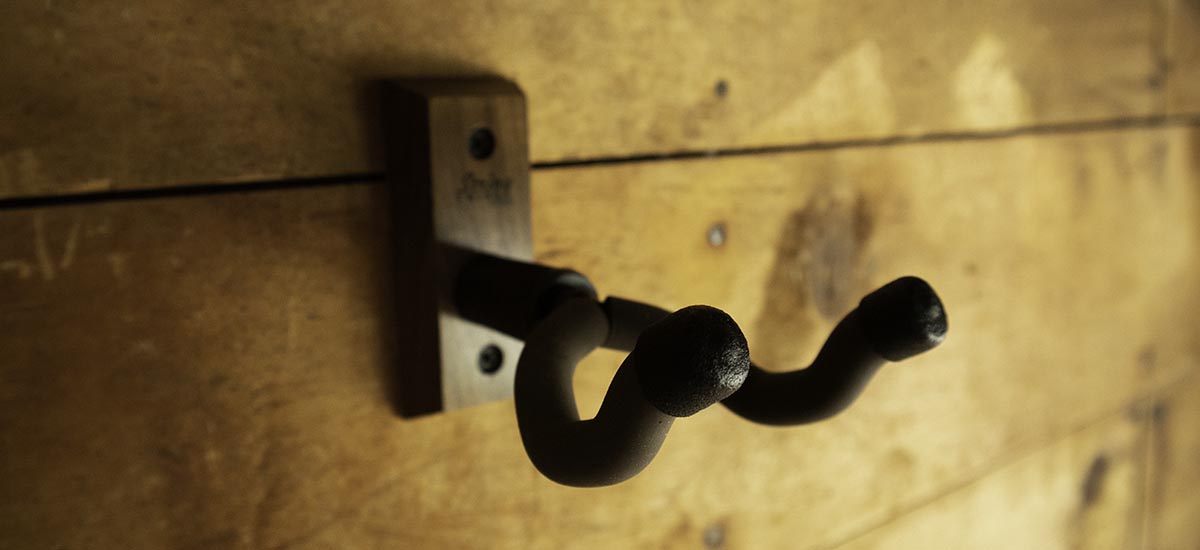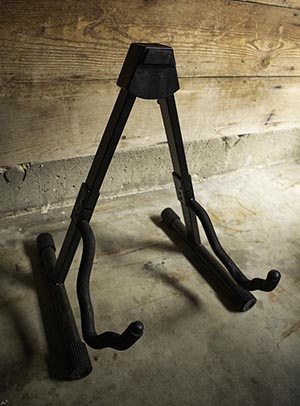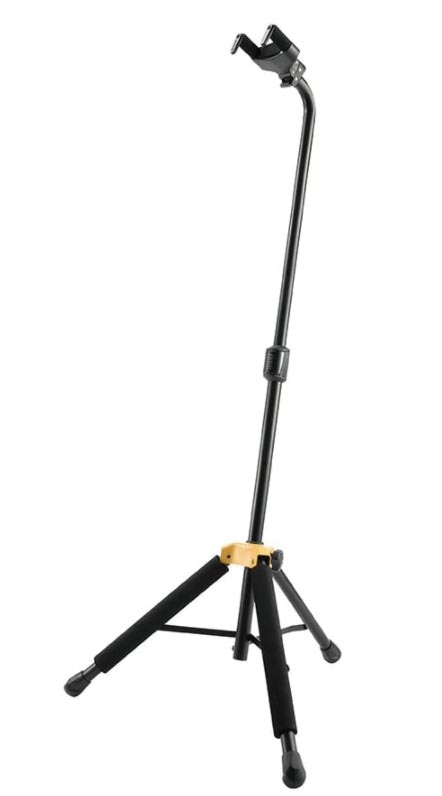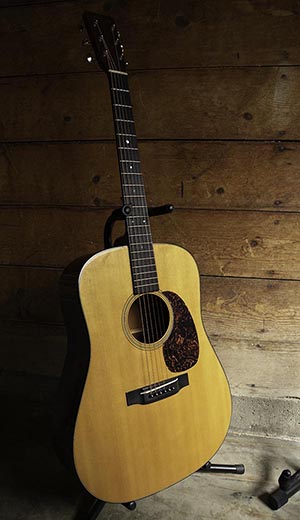Which is better, a wall mount or a floor stand for your guitar? Guitar wall hangers are great for neat presentation, protection from getting knocked over, and saving space. Guitar floor stands are great for certain space considerations, price, and when drilling into a wall isn’t an option. In this article we dive into the pros and cons of each so you can make an educated decision on how best to store your guitars.
I own and actively use all of the stands that I mention in this article. Each has their place with different pros and cons.
Is it better for a guitar to be supported by the body or held up by the headstock?
Central to this discussion is if a wall hanger or floor stand is better for the guitar itself. It’s obvious that a wall hanger (and Hercules style floor stand) has less overall surface area that touches the guitar. Less surface area means that the weight of the guitar is distributed across material which translates to higher pressure concentration on specific spots on a guitar.
While the floor stand does offer more surface area for a guitar to be held, I have never heard of or experienced a guitar being damaged from hanging from its headstock. If your guitar is fragile, extremely vintage, or has had a headstock repair that makes the structural integrity questionable, consider using a good floor stand.
However, I’m not docking points for either the floor stand or wall hanger. A healthy guitar should have no issues with either of these types of stands.
Table of Contents
Looks
I love the way a guitar looks hanging on a wall hook. It brings the guitar up off the floor and gives it the prominent position your baby deserves. However, it isn’t always practical to mount something to the wall, and a guitar on the wall can sometimes detract from the vibe of a room.
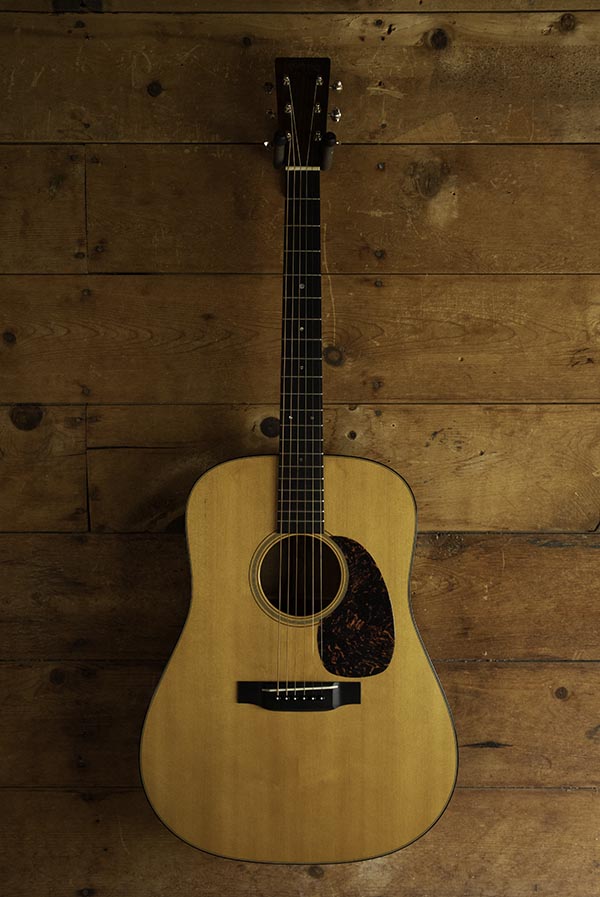
If the guitar is going up in a living room it might be a bit much. If it’s going up in a music room, then it will absolutely look awesome mounted to the wall.
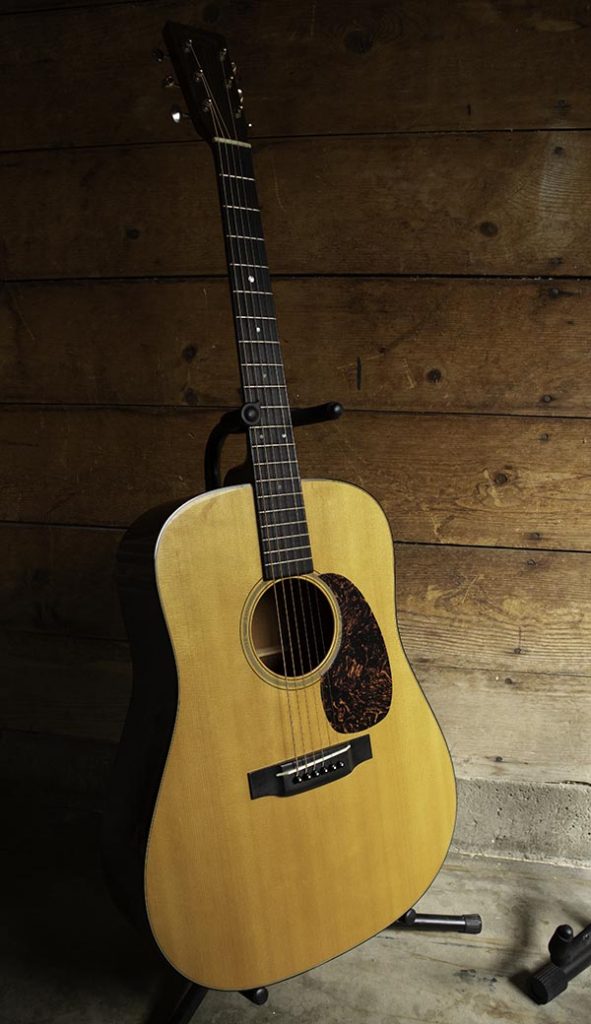
This category is a close one because it depends on the room, but I think ultimately the wall hanger takes it.
In my opinion, a guitar looks better hanging on a wall mount
Damage
One of the clear advantages of a wall mount is that it gets the guitar off the floor, away from kids, pets, and the occasional Tasmanian devil that tears through the house. If this is at all a concern, a wall hanger is well worth the peace of mind knowing that a small child can’t push over something hanging on the wall. Although I’m sure the small children would happily accept that challenge.
Some floor stands do a better job than others at creating a stable base for the guitar. The worst of these are the simple tubular stands with small bases. While I use these extensively, they don’t offer much in the way of protection from being tipped over.
The next best floor stand would be the A-frame style. These stands have a solid base of four feet. While they can wobble on uneven surfaces, the pure mass offers a clear advantage over the tubular stand. While these work well for acoustic guitars, I wouldn’t recommend them for electrics as the body isn’t typically deep enough and they can sit awkwardly in the stand leaning too far back.
The best floor stand for stability is, without question, the Hercules style that holds the guitar by the neck and the body leans against the stand. The Hercules is almost 3x more expensive than a normal tubular stand, but the extra security is well worth it. You’ve spent good money on your guitar, now make the investment in a decent stand to protect it.
The clear advantage that a guitar wall hanger provides is that it minimizes the surface area of the guitar that is exposed to potential moving objects. Another common issue with floor stands, especially in a studio space, is the opportunity for instrument and mic cables to get caught on the floor stands legs and pull the whole thing over. This is a problem the guitar hanger solves by getting a guitar off the ground.
By virtue of its design, a guitar wall hanger completely protects the back of the guitar and therefore minimizes the sheer amount of guitar that is available for damage. If a main concern is damage from things around the house (kids, pets, gnomes, etc.) get a guitar hanger.
The winner of this category is, again, the wall hanger for getting the guitar off the floor and keeping it close to the wall therefore minimizing the space the instrument takes up.
Stand Rash
As detailed in Should I Leave my Guitar on A Stand?, there is some reason for concern around leaving your guitar on a stand or hanging in a wall hanger. The concern here is that the stand material that is actually making contact with the guitar will cause some damage to the finish of the instrument.
Guitar stand contact points should be made from soft foam that will not break down over time or leave any discoloration on the instrument where it touches the stand.
However, extra care needs to be taken for any stand type if your guitar has a fragile finish as is often found on older, vintage instruments with hand rubbed, or thin nitro finishes.
Make sure that the stand you’re using doesn’t have plastic or rubber touching the instrument. These materials often begin to break down after some time and will potentially discolor the guitar. This goes for both floor stands where the guitar sits on the stand supports, and wall mounts where the guitar hangs from the headstock.
If you’re using a modern stand, there most likely isn’t much to worry about as all new stands I’ve seen use the proper foam material. However, it’s important to pay attention to the potential damage a stand may be causing the instrument.
Neither a floor stand or a wall mount should have any negative effect on the instrument however, I have to give the advantage on this one to the wall hanger based purely on the smaller surface area a wall mount provides when holding the guitar.
Convenience
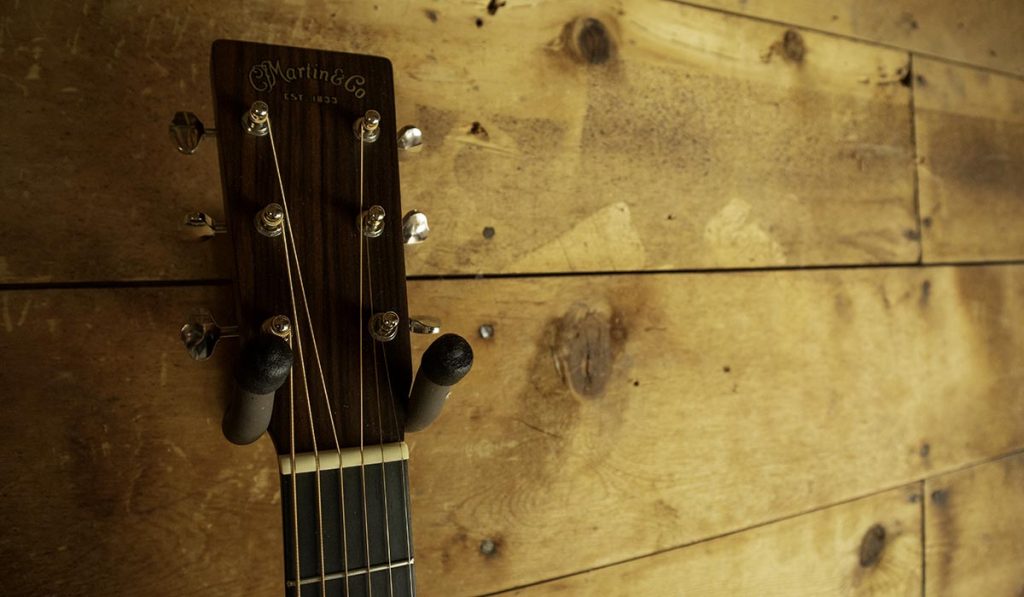
Outside of keeping your guitar out of harm’s way, this is the most important category of them all. Which option is going to get you to pick up your guitar more often.
Some will probably say that it doesn’t matter and you could put their guitar deep in the NORAD mountain and they’d still get to it and play every day. Well good for those guys, but I know that psychologically I’m much less likely to just pick up my guitar if it is harder to get to.
This is why I’m all about setting up a dedicated guitar space that allows for the easiest path of getting the guitar out of its stand and into your hands. In fact, this is why I always advocate for keeping your guitar on a stand when possible (though read the next section on humidity if you have an acoustic guitar).
Wall hangers can be great because they keep your guitar out of the way, but sometimes that can be a downside. If you have to climb over the couch, navigating the sea of remotes and the island chain of pillows, you’re probably going to be less likely to pick up that guitar everyday.
If you are putting up a wall hanger for your guitar, consider placing it in a spot that is incredibly easy to access. Remove as many barriers as possible to you picking up your guitar everyday. I know I keep saying that, but I’m not going to stop anytime soon. Pick up that dang guitar!
The floor stand wins this category. It’s almost always easier to pick up a guitar off of a floor stand that is right next to your favorite chair than it is to pull a guitar off a wall hanger that may or may not be in an accessible spot.
Humidity
What kind of guitar are you buying this stand for?
Do you have an electric guitar? [LINK: Do you need to humidify electric guitars?]
How about an acoustic? [LINK: All you need to know about humidity]
If you are putting an electric guitar on a stand, you most likely don’t need to be too concerned about humidity. If possible, keep that room in the 45% – 55% humidity range that guitars like, and you shouldn’t see any issues.
However, if you are putting an acoustic guitar on a stand, make sure that it is getting the proper humidification. If it’s impossible to keep your guitar room at 45% to 55% humidity by using a humidifier, then you need to keep your guitar in its case with a good case humidifier, keep it on the stand but use a soundhole humidifier like a DampIt.
The soundhole humidifier has a cover that both holds the damp sponge inside the guitar, and keeps the moisture from escaping directly out of the soundhole. These humidifiers do an incredible job of keeping an acoustic guitar moist and happy from the inside out. Ignoring humidity issues with acoustic guitars is a recipe for a poor playing guitar that could develop cracks or other permanent damage.
Both the wall hanger and the floor stand have the same amount of exposure to humidity issues. There is no winner on this one. Humidify your guitar or else you’ll be wishing you did when cracks start to show up.
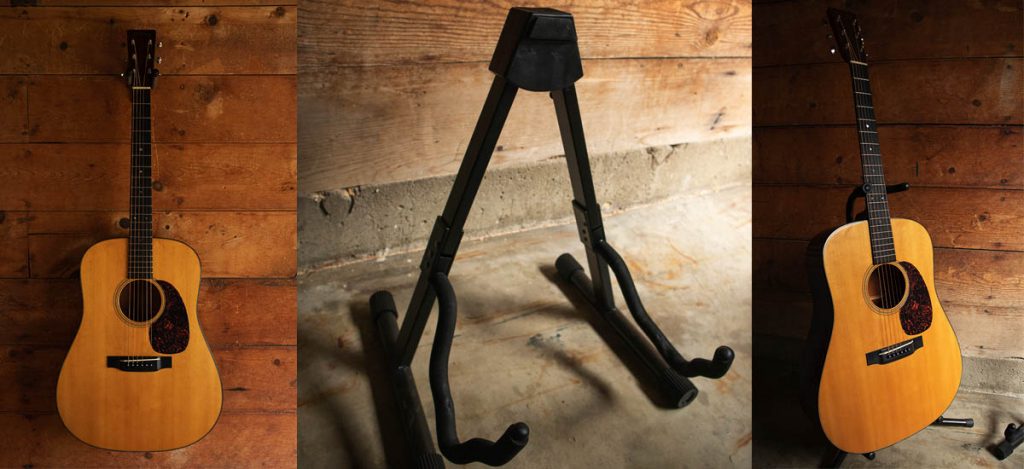
Installation
A floor stand doesn’t have any installation and is typically all ready to go right out of the box. Just make sure it’s on a level surface away from things that could pull it over and you’re all set to go.
A wall hanger on the other hand needs to be mounted to the wall. While the String Swing hangers that I use come with drywall anchors, I highly recommend finding a stud and mounting the wall hanger to that. I feel much better about my couple-a-thousand dollar Martin or Gibson hanging from two 3” screws that are deep in a 2×4 than in some plastic anchors in a chunk of drywall the condition of which is unknown.
According to naturalhandyman.com, plastic drywall anchors can pull out of drywall with as little as 10 pounds of force. The heaviest guitar I own is a Gibson ES-137 which comes in at a back wrenching 9 lbs. This is even on the light end of most Les Pauls! An LP can easily break that 10 lb mark, many coming in at 11 or 12 lbs.
I wouldn’t ever risk putting a guitar in a wall mount that isn’t going into a stud. If hanging multiple guitars (and you don’t want them on 16” centers), consider mounting the wall hangers to a flat piece of 1” board which then gets anchored to the studs.
If you’re unsure about where to drill to mount a wall hanger, go to YouTube and search for “how to find a stud.”
A potential downside of a guitar wall hanger is the installation process. I would highly recommend having a drill to first pre-drill the screws in the wall before sending them into the stud. This will make your life much easier when screwing in the fasteners, and prevent a stud from cracking or blowing out.
The clear winner in this category is the floor stand, as no installation is required and no danger takes place from an incorrectly installed hanger.
Conclusion
I love wall hangers because of how professional, and finished they look. However, care must be taken to ensure proper installation before trusting this little piece of hardware with the life of your precious guitar.
If a floor stand is a bit too rickety for you, consider upgrading to a Hercules stand that features a wide base and secure neck clamp that makes knocking the guitar off the stand almost impossible.
I personally have one guitar on a hook and the rest on floor stands, mostly for ease and flexibility. As I build out my studio space I’ll be installing more wall hooks for my guitars.
